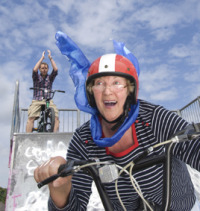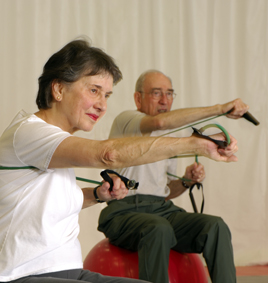By Ann Gates, @exerciseworks
 ‘Keeping Gran and Gramps fit and healthy’ should be part of the Olympic legacy in its truest sense and part of every nation’s health priorities. Regular exercise and increased aerobic fitness are associated with a decrease in all-cause mortality and morbidity. They are also proven to reduce disease and disability, and improve quality of life in older persons. On a patient level in relation to disease and falls prevention, Salkeld et al (2000) reported in the BMJ: ‘80% of women would rather be dead than experience loss of independence and quality of life that results from hip fracture and admission to a nursing home’.
‘Keeping Gran and Gramps fit and healthy’ should be part of the Olympic legacy in its truest sense and part of every nation’s health priorities. Regular exercise and increased aerobic fitness are associated with a decrease in all-cause mortality and morbidity. They are also proven to reduce disease and disability, and improve quality of life in older persons. On a patient level in relation to disease and falls prevention, Salkeld et al (2000) reported in the BMJ: ‘80% of women would rather be dead than experience loss of independence and quality of life that results from hip fracture and admission to a nursing home’.
With quality of life and quality of health epitomising the ‘gold medals’ of the older adult world, ‘Walk with Me’ initiatives provide inspiration for the global development of physical activity opportunities for older adults with volunteers, friends, families and within communities. This type of ‘best buy’ health intervention combined with every health professional providing exercise advice and support could be a fitting Olympic legacy and life changing intervention regarding the health outcomes of older adults.
The British Heart Foundation for physical activity and health (BHF) recently published three key papers that interpret and apply the UK’s Chief Medical Officers guidance on physical activity advice for ‘older adults’ (people aged 65 and older).
 This guide has 3 parts:
This guide has 3 parts:
Interpreting the physical activity guidance for active older adults
Interpreting the physical activity for guidance for older adults in transition
Interpreting the physical activity guidance for frailer, older people
The guidance emphasises the importance of incorporating the four main types of exercise that older people should enjoy as part of maintaining and promoting a healthy lifestyle namely, cardiovascular, strength, flexibility and balance exercises.
The BHF guidance has been published to coincide with the 8th World Congress in Active Ageing 2012, being held in Glasgow, Scotland, UK from Monday 13 August-Friday 17 August 2012. This conference is leading the world on how regular physical activity and structured exercise plans can transform:
- well-being, quality of life, cognitive functioning and dementias
- falls and fractures, balance and bone health
- neurological and musculoskeletal conditions and;
- cardiovascular and respiratory conditions
Inactivity, sedentary behaviour and poor patient access to quality exercise support contributes to many non communicable diseases (NCDs) that occur in older adults (such as: heart disease, stroke, diabetes mellitus, lung disease, Alzheimer disease, hypertension, and cancer). Lack of physical activity, combined with poor dietary habits has also contributed to increased obesity in older persons and the subsequent health problems of joint instability, pain, disability and immobility.
Recent research suggests that only 1 in 3 doctors give exercise advice as part of brief intervention within patient consultations. This highlights one of the critical dilemmas in which exercise medicine in the 21st century is facing in older adult care: the balance of providing proactive, timely, preventive healthcare or delivering a reactive, treatment focussed model of care. We know that physical activity prescription and healthy diet advice is a safe and cost effective way of helping patients and the public prevent and treat the health burden of non communicable diseases. This ‘Exercise is a Medicine’ approach has been extremely successful in some countries in the strategic and day-to-day management of a patient’s long term health problems. At a global and local level, these strategies for improved older adult care have yet to be implemented successfully in the majority of countries, including the UK. The startling facts that ‘by the age of 74, only 42% of men and 22% of women can walk for 30 minutes or more without difficulty; and similarly, because of low strength, 25% of women and 7% of men of this age are at risk of being unable to get out of a low chair’ is yet another call for action to address the physical inactivity epidemic within our global, national and local health communities.
The quality of exercise advice, support and provision in environments attractive and safe for older adults is a reflection of a nation’s pride and wealth in looking after the health of their older generation. A fitting Olympic legacy would be for all nations to help more older adults access regular exercise as part of their everyday lives (see this video for one example), and inspire everyone’s ‘Gran and Gramps to feel like an Olympian!’
*********************************************************************
Ann Gates from Exercise Works! will be running a lunchtime workshop at The 8th World Conference on Active Ageing 2012, Glasgow, on ‘How to give exercise advice and support to everyone!’
Ann Gates BPharm(Hons) MRPharmS
Personal Trainer, Chronic Disease Exercise Specialist, BACPR Exercise Instructor,
email: ann@exercise-works.org